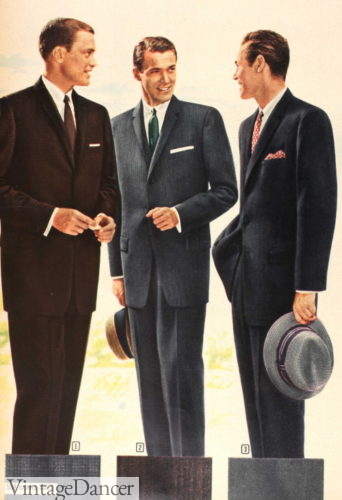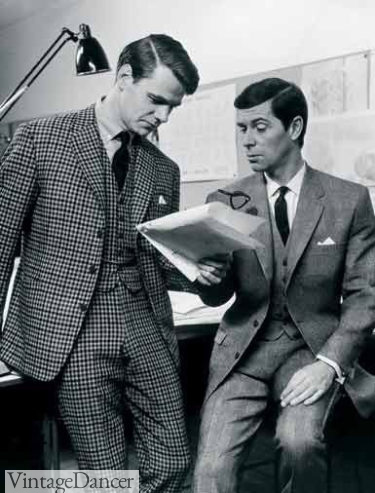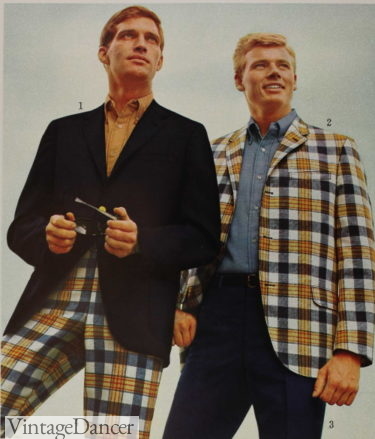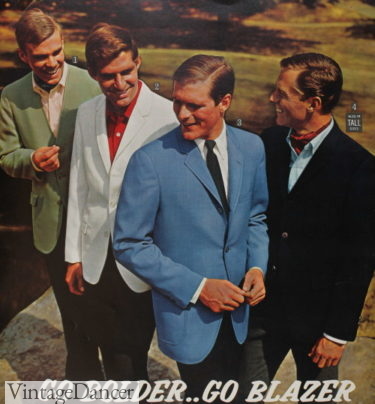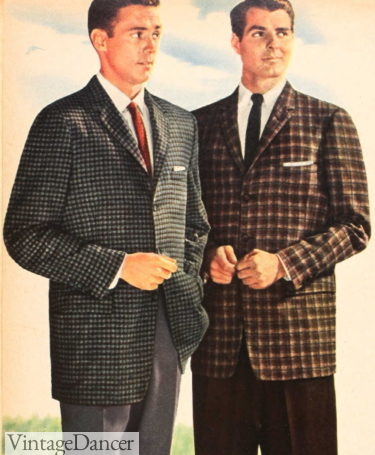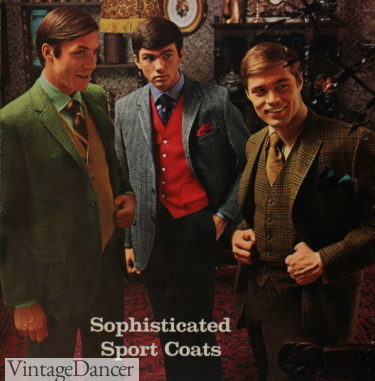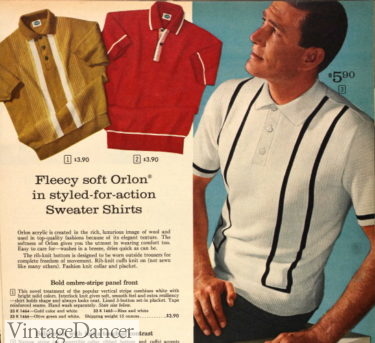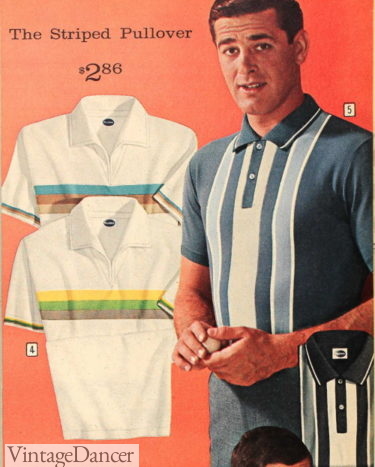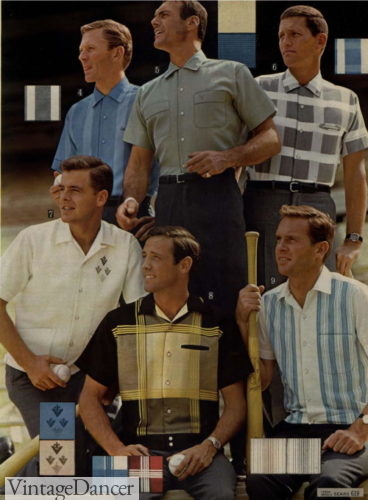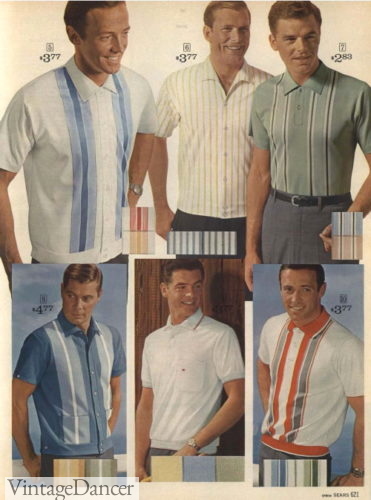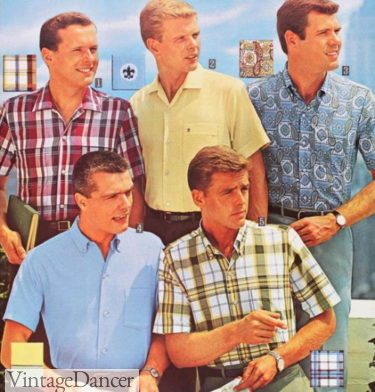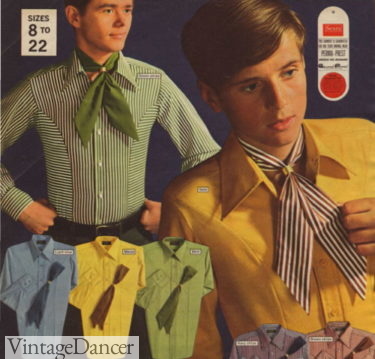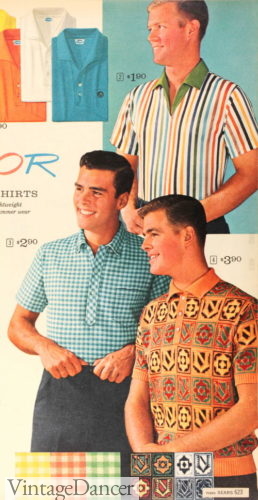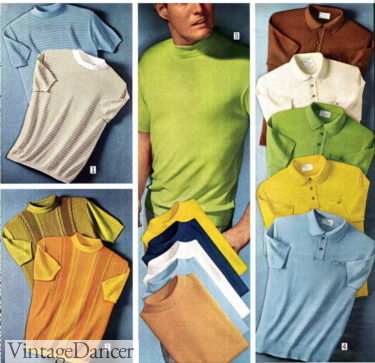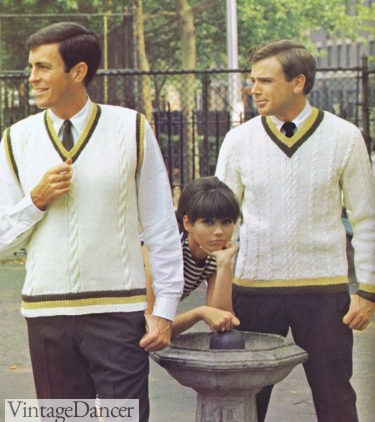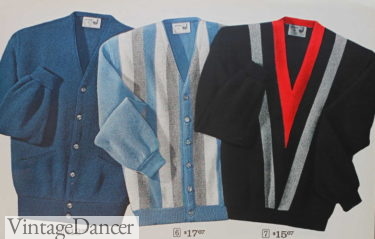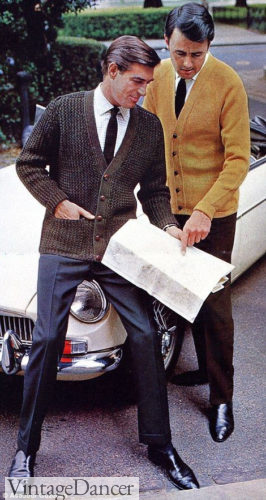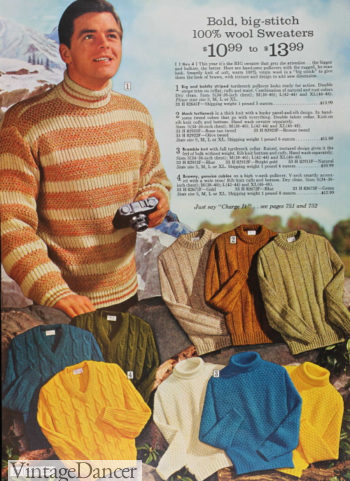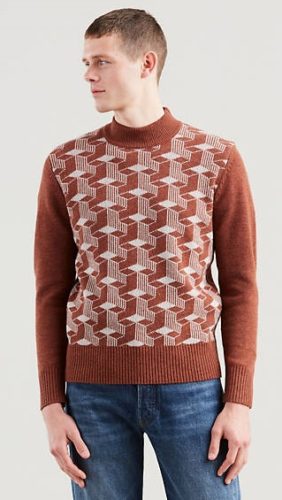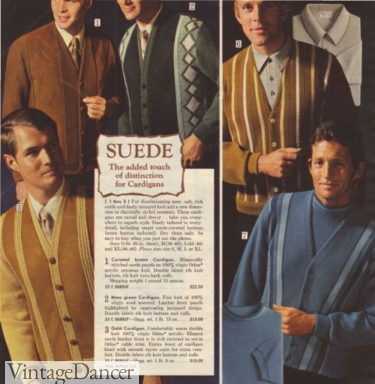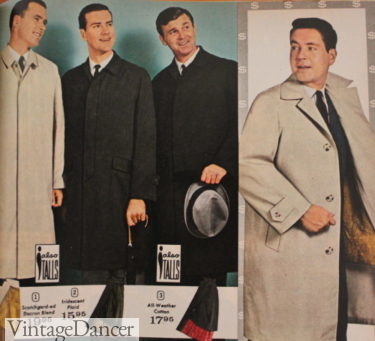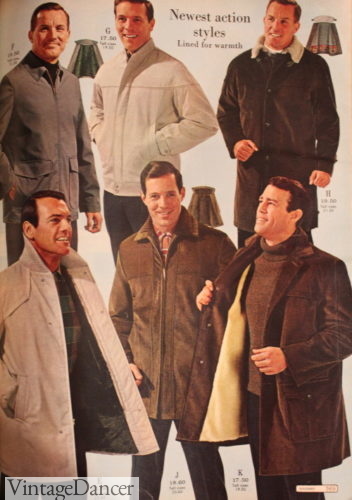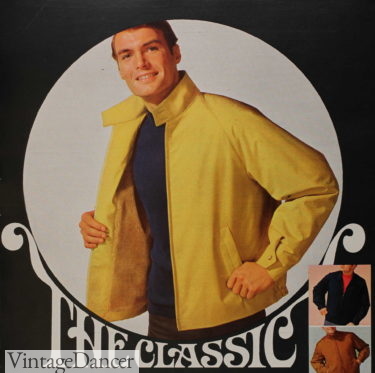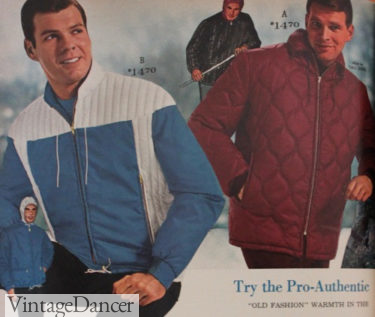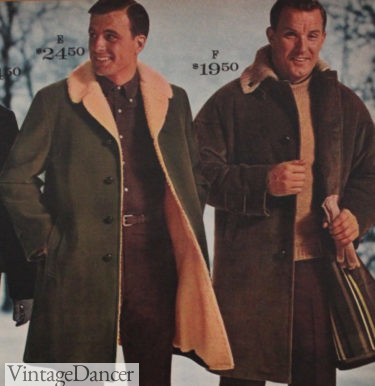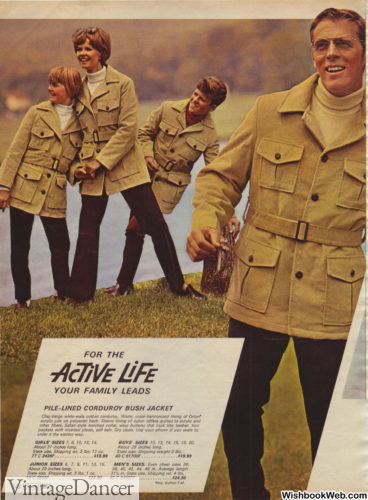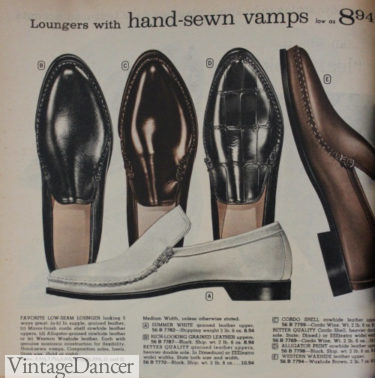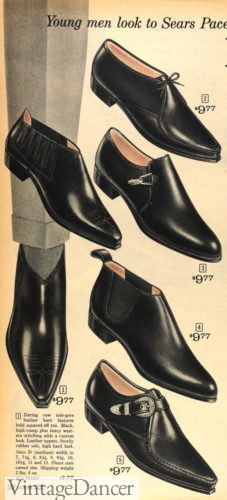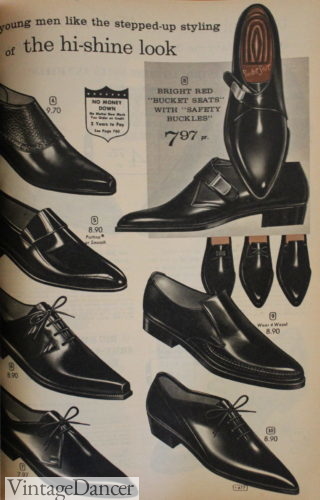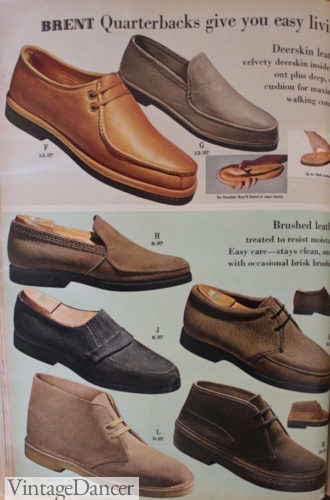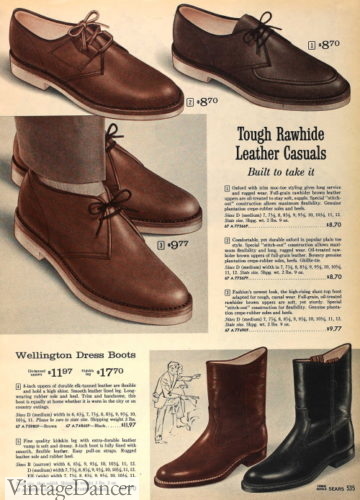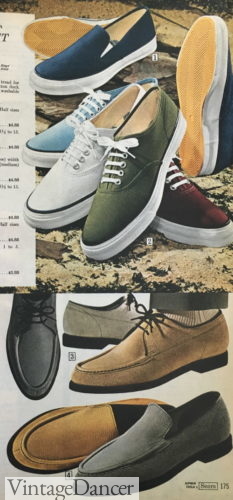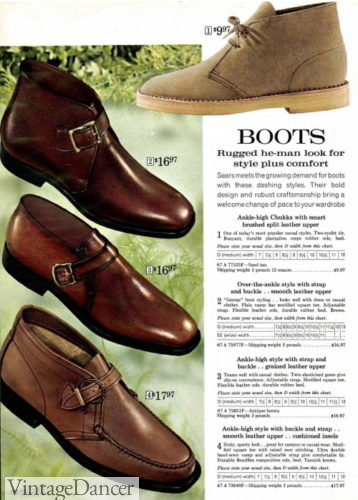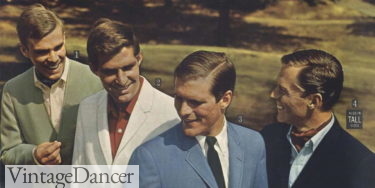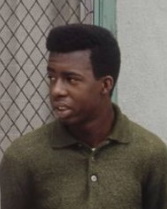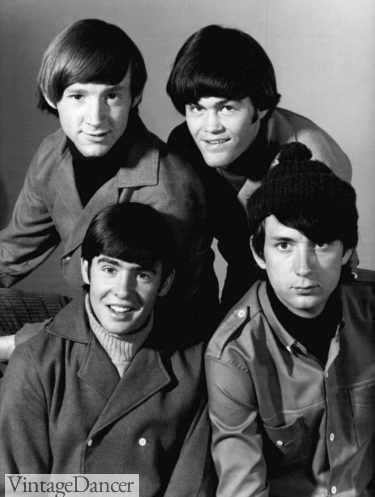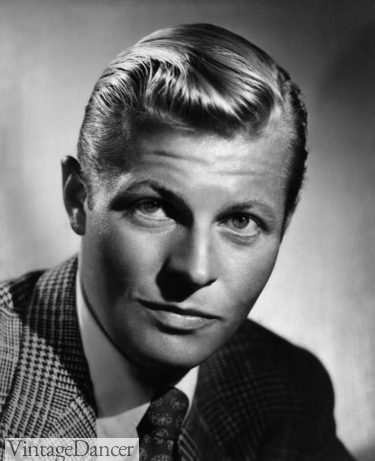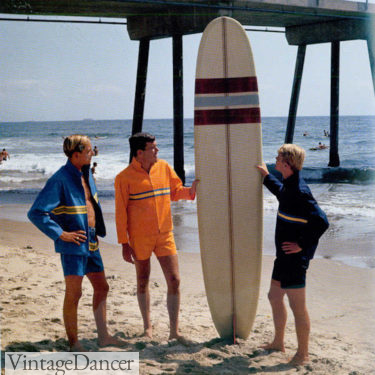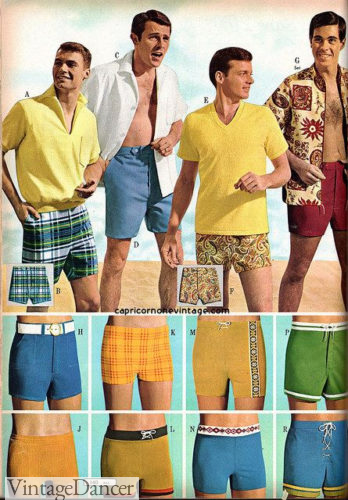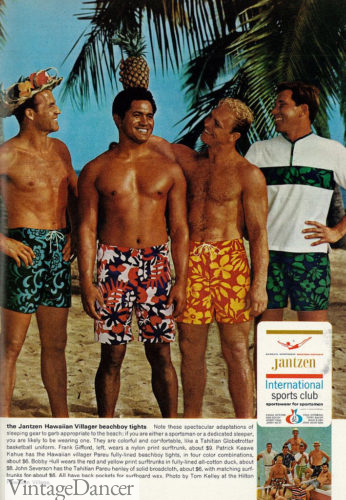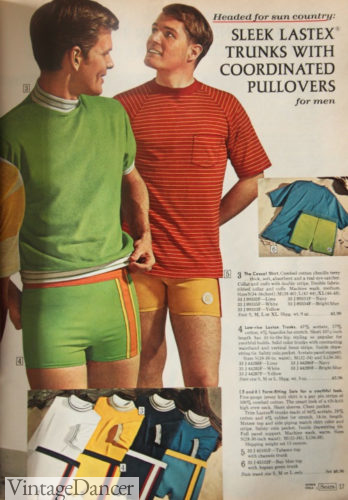By 1965, half of the USA’s population was under 25 years of age. The young men and women of the ’60s had witnessed social injustices of their parent’s generation and wanted change. That change even reflected in 1960s men’s clothing, contributing to a continuation of casualness, a slimming of the figure (boyish shapes), and brighter colors and patterns last seen in the late 1920s.
Shop 1960s style men’s clothing:
Shirts | Pants | Shoes | Suits | Hats | Costumes
1960s Men’s Fashion History
Most 1960s men’s fashion history books focus on fashions in London. Very little is discussed of American men’s fashion which, although it had some influence from London, also had its own uniquely casual American look. We will discuss both styles in this article but focus more heavily on American clothing.
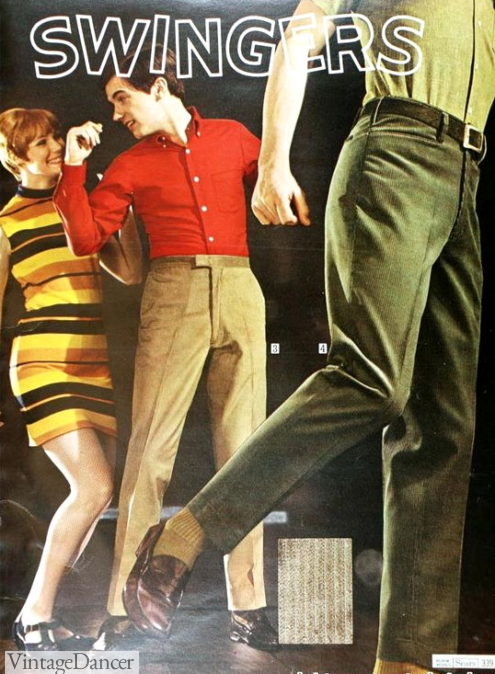
1967 Men’s Fashion
The 1960s men’s everyday look consisted of slim-fit trousers, a button-down shirt or polo shirt, and a patterned sport coat. This Ivy League look started on college campuses, but was adopted by businessmen who began to wear it instead of traditional conservative 3 piece suits. The Ivy style gave way to the mods, influenced by British fashion and music icons. This, in turn, changed again as the American hippies took over in the late ’60s with their recycled vintage, back to the earth roots, and peaceful defiance. All three distinct looks influenced each other, creating an overall modern fashion decade.
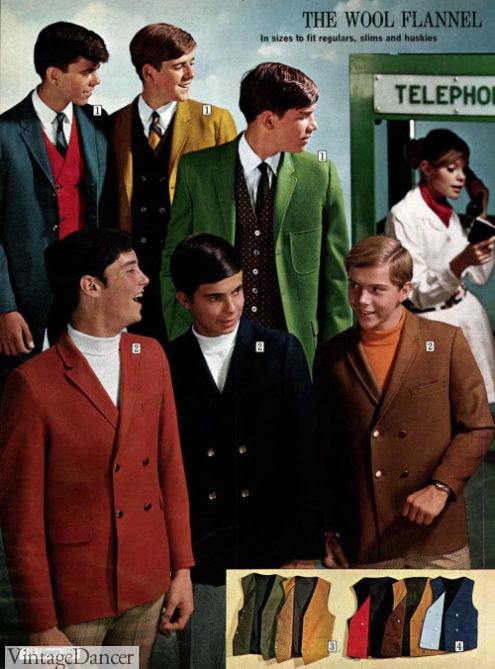
1969 Men’s Mod Fashion
The Peacock Generation was one name given to British men’s fashion in the late ’60s. It referred to how fashionable young men were putting themselves on display, inviting commentary, and expressing individuality by wearing a variety of unusual clothing. Color were brighter, patterns bigger, clothes tighter, and the price tag cheaper. Fashions changed quickly, and young men flocked to small boutique stores in big cities to get the latest flashy outfits.
1960s men’s clothing was overall worn tighter to show off youthful bodies. Shirts were unbuttoned to show off a bit of chest and pants were lowered down to the hip. Bold colors and big color block patterns shouted “Here I Am.” Even basic suits and sport coats were worn with a bold pop of color, like a red vest or neck scarf. Older men who were afraid to adopt these stand-out statements still had plenty of greys and browns to wear, but even they adopted some of the newer slim styles in toned-down colors on the weekends.
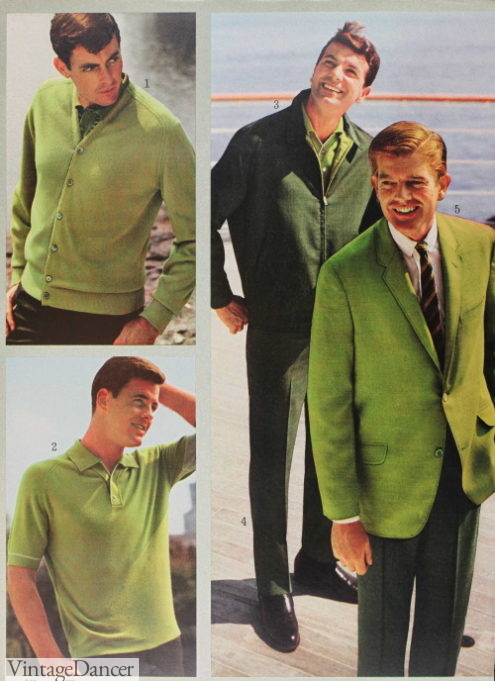
1966, Lime Green was a Popular Color in the Mid 1960s
The Conservatives and the Ivys: 60s Fashion for Men
1950s men’s fashion continued into the early ’60s, often called the Continental or Ivy Style. The continental look embraced the conservative man in the gray flannel suit who would cast off his lifeless suits for casual clothing on the weekends. Some of the key features are:
- Sportcoats with contrasting trousers, colored vests, dress shirts, and skinny ties. Fedora hat optional. Shop suits here.
- Casual polo shirts with solid or patterned trousers on the weekends, worn with a belt. Shop shirts and pants.
- Tennis sweaters, cardigans, and sweater-vests instead of sport coats. Shop sweaters.
- Athletic sweatshirts, T-shirts, and Cabana sets at home or on vacation.
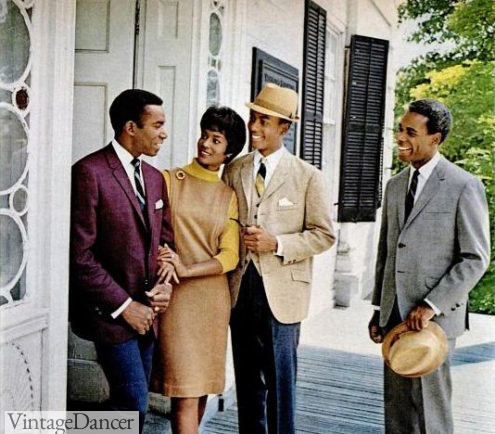
-
- Early 1960s Conservatively Dressed Men Begin Wearing More Color as well as Mixing Pants, Shirts, Sportcoats, and Hats
Men’s Suits and Sportcoats
Into the ’60s, men’s business suits continued to be dull and lifeless — bland greys and browns with the sack fit and single pleat leg. Some suits were updated slightly with textures like tweed or corduroy, or given noticeable patterns such as plaid, checks, and herringbone.
Suits were modernized a bit with a lower waistband, flat-front trousers, narrowing lapels, and 2- instead of 3- button jackets, which eventually dropped down to just 1 button. Suit jackets were also being worn over non-matching trousers. Keeping jacket and trousers in the same color family kept the look conservative enough for the office.
These updated suits that were worn without a hat, and often called the “JFK Look.” Across the pond, a 3 button suit jacket with a high neck was dubbed the “Britisher style.”
- 1960 Conservative or Continental Suits
- British Three-Piece, Three-Button Plaid Suit
Outside of the office or to a business casual lunch, men could wear the latest trend for sportcoats in bold patterns and contrasting colors. This look was heavily influenced by the Ivy League style, which wore mismatched suit jackets and pants with a bold colored suit vest or sweater vest. Red and yellow were the most popular vest colors that popped under dark blue, grey, or tan sportcoats. Dark vests were worn with lighter colored jackets. Brightly colored dress shirts replaced vests in the mid to late 60s.
- 1966 Plaid Pants or Sportcoat with Solid Trousers
- 1965 Solid Blazers, Contrasting Trousers and Shirts
- 1960 Small Check Sport Coats
- 1969 Sportcoats, Vests, Tie, and Trousers – All in Mismatched Colors and Patterns
Sport coat colors and patterns grew bolder as the decade progressed. Subtle and muted patterns in the early years gave way to wide boater stripes, large plaids, windowpane, and black and white checks or herringbone. Solid colors such as red, ivory, white, bright blue, light grey, and mustard yellow were equally paired with dark trousers in another solid color (or pattern in the later years). The final years also saw an explosion of pastels and pinstripes, a nod back to the mid-1920s. Baby pink, sky blue, and sunshine yellow were spring and summer favorites.
Shop men’s 60s suits and sportscoats.
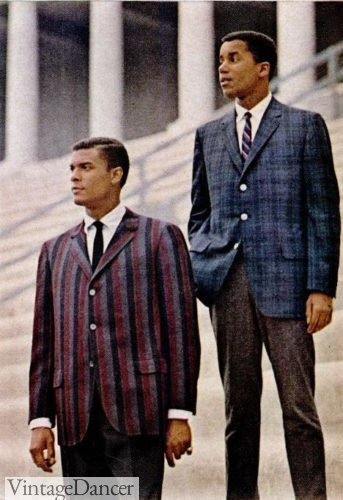
Mid 1960s, Boater Stripe and Plaid Sport Coats
Men’s Dress Shirts and Ties
Dress shirts were white, pinstriped, or pastels for most of the decade, letting the outerwear be the focus. Neckties could be solid, wide striped, or patterned, but again to keep in balance with the outerwear, neckties were usually plain or striped, dark, and very skinny ties. Skinny ties balanced with thin lapel coats and narrow shirt collars.
In the late 60s, men’s dress shirts exploded with rich colors, small patterned ties, and flashy gold cufflinks. Ties were still skinny, but gradually widened to a classic width as suit lapels began to widen. Shop ties.
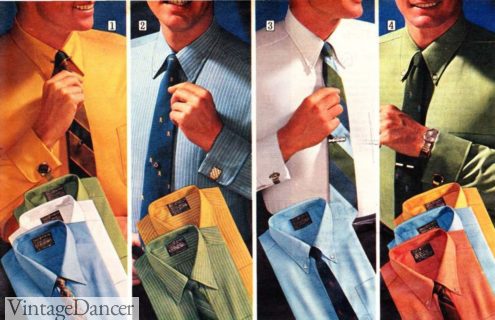
1968 Colored Shirts, Skinny Ties, and Cufflinks
An alternative to the tie came in the late 60s – the neckerchief. The neckerchief was folded like a cravat around the neck and puffed out from under an unbuttoned shirt collar. The look was suave against the brightly colored shirts and sport coats. This was often too mod of a look for the conservative set, but the young Ivys found it liberating compared to the noose of neckties.
Learn more about the history of men’s neckties.
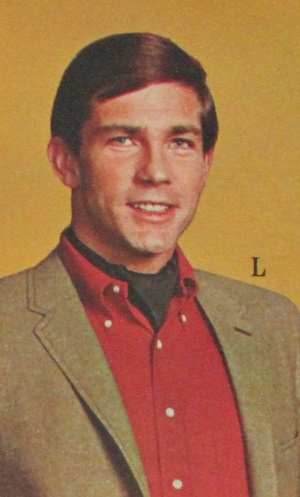
1967 Black Neckerchief Under Red Shirt and Brown Sport Coat
Men’s Casual Shirts
Casual clothes for the conservative or Ivy set turned to the golf or country club look: polo shirts, skinny belts, and single pleat or flat-front trousers. Polos, also called sweater-shirts, were often trimmed in contrasting stripes or made up in large two-tone color blocks, a carryover from the ’50s. Some featured printed designs reflecting the Atomic Age/Space Age. Many had zip-up collars instead of buttons. The horizontal striped polo shirt mimicked classic fisherman shirts, while vertical panel shirts were borrowed from 50s bowling shirts.
- 1962 Piped Polo Shirts
- 1963 Men’s Horizontal Stripe Polo Shirts
Besides the polo, the button-down shirt in plaid, stripes, or prints remained the essential men’s shirt for almost every occasion. Western shirts with piping trim were frequently seen in small-town America. Camp shirts, worn untucked, remained popular summer shirts.
- 1965 Button Down Shirts
- 1965 Vertical Stripe Panel Shirts
- 1966 Men’s Button Down Shirts in Plaids, Stripes, and Paisley Patterns
- 1969 Men’s Large Collar, Slim Fit Shirts with Scarves
The mod look influenced casual shirts, even for conservative men with an increase in bold color combinations, stand out stripes, and multi-color plaids. Of course there were plain colors too, such as pastels in spring, saturated colors in the fall, and earth tone colors in the late 60s. Contrasting white buttons gave them a modern look. Collars were also small and wide-set.
Learn more about men’s 1960s shirts.
- 1962 Knit Shirts – Stripes, Gingham, and Tile Print
- 1969 Mock Neck Knit Shirts and Polos
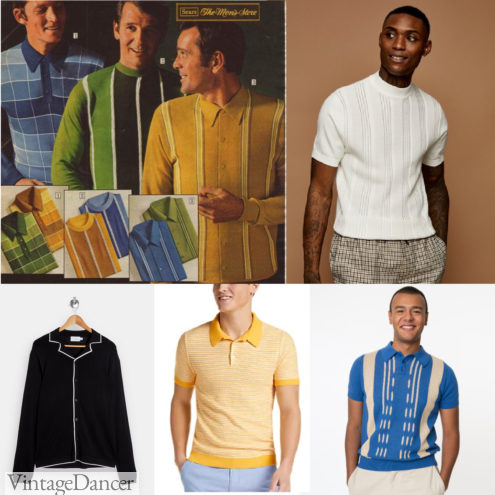
60s-70s Style Men’s Knit Shirts – Shop Shirts
Men’s 60s Sweaters
Just like shirts, men’s sweaters took on similar colors, stripes, and color-blocked patterns. The pullover sweater (jumper) and cardigan achieved a new status of high fashion when Italian knitwear makers Missoni and Gino Paelo introduced innovative designs and knitting techniques. Sweaters appeared with jeans at ski resorts or just around town for the average man who wore it as a replacement for a sport coat.
Large Chevron or wide stripe blocking, geometric tile designs, chunky knits, and new textures such as mohair went mainstream quickly. Ivy Leaguers latched onto the sweater revival, not only with new designs, but with the classic Tennis or Letterman sweater, sweater vests, and V neck cardigans.
Shop men’s 60s style vintage sweaters.
- 1960s Ivy Style Tennis Sweaters and Sweater Vests
- 1964 Mod Vertical and Chevron Stripe Cardigan and Pullover Sweaters
- Classic Cardigan Sweater for the Conservatively Dressed
- 1968 chunky knits in crew, V and turtlenecks
- Levis reproduction 60s geometric tile sweater
- 1969 Earth Tone Knitwear
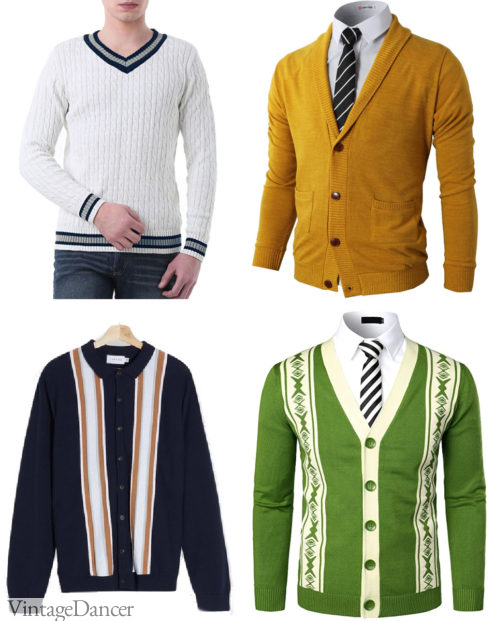
60s Style Men’s Sweaters and Cardigans – Shop Now
Men’s Overcoats and Jackets
Outerwear coats in the first half of the 60s remained similar to the conservative 50s. Knee-length car coats and overcoats (called Knee Breakers in Britain) topped men’s business suits. Short guards coats, camel hair overcoats, polo coats, British warm coats, and plaid car coats hit just above the knee. The shape was slimmer with double-breasted coats — especially trench coats — leading the fashion trend. There were also boxy bone-colored mac coats, which were perfect for spring.
- 1961 Mac Long Coats
- 1967 Neutral Color Short Coats
For more casual looks, the sherpa lined suede hip-length coat or quilted puffer jacket offered better warmth without the weight. For spring days, the Harrington jacket (light bomber style) continued to be a casual favorite for young and old. In 1969, the bush jacket returned to fashion with four pleated pockets and a belt. Winter ski jackets favored the the puffer quilted jacket while spring athletes liked the windbreaker.
- 1969 Harrington Jacket
- 1964 Puffer Winter Sport Jacket
- 1964 Sherpa Lined Coats
- 1969 bush jackets
60s Shoes for Men: Slip on Shoes
Most men continued to wear Oxfords and moc toe shoes for all occasions, however it was the slip-on loafer types that took off in the ’60s. Even conservative men enjoyed the ease of slipping into a pair of shoes instead of dealing with tie laces. Toes were pointed in the early ’60s and blunted by the later years. Black shoes were favored over brown, and shiny was better than matte.
The Ivy kids loved a classic penny loafer or moccasin shoe. Shoe designs were clean, smooth, and minimally embellished. The newest invention was the white leather loafer with black sole, worn with white pants and sportswear in the summer. It crossed the border into mod style, yet real mods hardly ever wore them.
- 1960 Men’s Dark Brown Loafers and Oxfords
- 1961 Loafers
- 1963 Shiny Black Mod Shoes with Pointy Toes
- 1964 Shiny Black Shoes
With casual clothes came the slip-on and tie shoes in lighter colors (bone, grey, tan) and soft textures such as suede. The suede chukka boot was another popular option on college campuses. As pant hems rpse, boots became more popular in the mid-60s with all men.
- 1960 Suede Slip-Ons and Chukka Boots
- 1963 Lace Tie Boots and Wellington Boots
- 1968 Canvas Casual Shoes
- 1969 Buckle Boots and Shoes
60s Men’s Hats & Hairstyles
Conservative men couldn’t think of leaving the house with a hat, yet the new generation took pride in their perfectly combed hair. Some people blame President John F Kennedy for promoting hatlessnes, while others chalk it up to the Youthquake movement. This doesn’t mean there were no hats, only new styles to reflect a new culture.

1961 Fabric Stingy Brim Fedora Hats
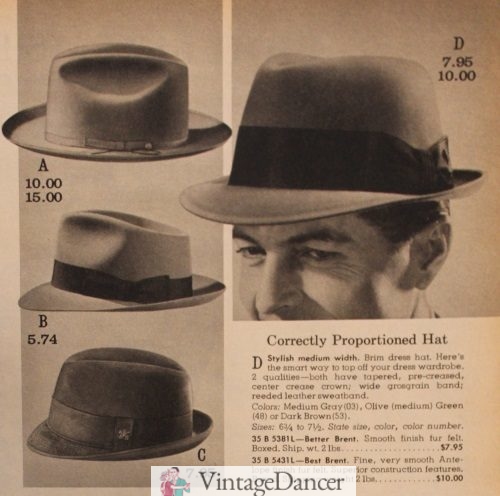
1964 Men’s Felt Hats – Shorter and Narrower than the 50s Styles
The first was the snap-brim fedora — a short crown, V-dent, narrow brim fedora with a snap-up brim at the back. Made of dark felt in winter and light sennet or coconut straws in summer, they had hatbands they were more detailed in design instead of the classic wide stripes. These hats complemented the new slim suits perfectly. Even the mods wore them. Learn more about 1960s men’s trendy hats and shop mens ’60s style hats.
Read about 1960s men’s hairstyles and facial hair here.
- 1965 classic comb over
- 1965 semi pomp
- 1966 Monkees – bowl cut
- Kurt Kreuger – waved
Swimwear / Surfer Clothes
Displaying young and fit bodies at the beach created a shift in men’s swimwear. The bikini brief for men lowered to below the belly button, and stretchy knits made them more supportive and comfortable to wear. Boxer style swim trunks also lowered a bit and raised up in the leg. The surf style (boardshorts) had longer legs and a drawstring waistband. Colors were bright horizontal stripes as well as psychedelic prints that rivaled non-beach clothing.
The matching cabana set (trunks and camp shirt, t-shirt, or shirt jacket) was an absolute must-have at the poolside (and a perfect cover-up for the not-so-young-and-fit bodies). The only truly new design were the Basketball trunks, cut with a tulip-edged side seam and white piping that appeared around 1966 and carried well into the ’70s. Learn more about the history of men’s swimwear and shop retro swimsuits and cabana sets here.
- 1965 Surfer Fashion
- 1967 Men’s Swimsuits and Shirts
- 1966 Surf Shorts – Longer Leg, Drawstring Waistband
- 1968 Swim Shorts and T-Shirts
Subculture: The Mod Fashion
Part throwback to the Edwardian age and part futuristic, Mod men’s clothing blended old and new together in a look that could be conservative yet trendy, or outright flamboyant. The look dominated the UK but was less mainstream in the USA. Fashion-forward young men were the primary audience who looked to buy Mod clothing, thinking it would attract young girls who were obsessed with the British bands.
Read about the American men’s 60s mod style here.
Subculture: The 60s Hippie Men
Around 1967, a new era of culture and fashion was replacing the Mods. Counterculture events, gatherings, and peaceful protests were happening in major USA cities. San Fransisco had The 1967 Summer of Love, which was a celebration of global multiculturalism as well as antifashion, non-conformity, and anti-consumerism. In New York, Woodstock 1969 drew over 400k young music fans to a peaceful 3-day concert series.
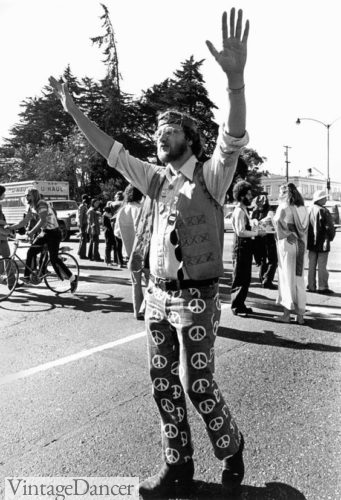
Hippie Peace Pants Protester
The hippies rejected fast fashion, shopping at thrift stores instead. They purchased anything ethnic, western, well worn, or gender-bending. They learned to make bead necklaces and headbands, tie-dye T-shirts, and tool leather. Recycled clothes were upcycled with patches, embroidery, and beading. Trimmed with suede fringe, topped with a floppy western hat, and worn with flared jeans, the men’s 60s hippie look was something the mainstream world couldn’t comprehend.
In the first years, they also borrowed psychedelic clothing that had entered the mainstream. Vivid swirls of color on shirts and pants mixed with fringe vests and boots. The clash of color, style, and texture made hippies the creators of the Trippy style.
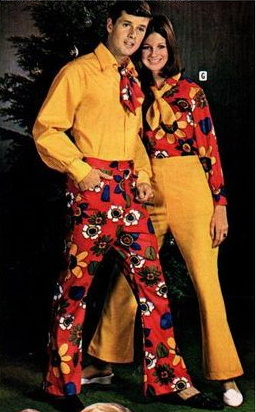
1969 Flower Power Hippie Clothes
Hippies also created historically inspired throwback fashions. By shopping at thrift stores, they were able to buy dramatic vintage clothing or recreate historical styles from the Renaissance on up to the Art Deco Hollywood age. Mixing heavily decorated velvet jackets, white ruffle dickies, heavy gold chain necklaces, and psychedelic flares, the Retro hippie look was a costume for those with something important to say.
The final hippie look was the ethnic style. Traditional clothing worn by men in the Middle East was seen as the opposite of tailored Western fashion. Wearing an African Dashiki, Indian Batik tunic, or Native American jewelry and moccasin boots spoke to the old cultural traditions of handmade wearable art long gone from American society.
Learn more about 1960s hippie fashion part 1 and part 2 and 1960s men’s hippie fashion and outfit ideas here.
1960s Men’s Costumes
Dressing in the 1960s style today is fairly easy. Thanks to a revival of the Mod look, especially in the UK and the boho hippie look in the USA, there are plenty of choices locally as well as online. Here are a few outfit ideas to get you planning your next 60s outfit. Don’t forget a ready-made costume for Halloween too.
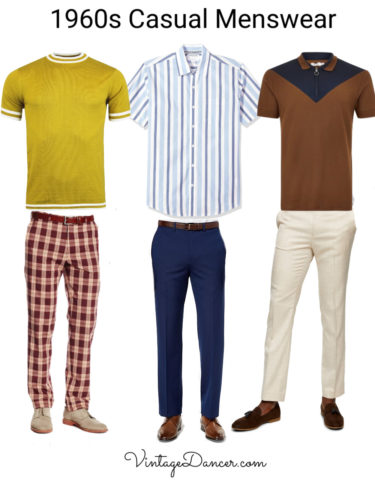
60s Men’s Casual Outfits
Read More
- 1960s Men’s Outfit Ideas
- Men’s Hairstyles and Facial Hair of the 1960s
- 1960s Mod Style for Men
- The Evolution of Men’s Ties, 1920s-1970s
Shop 1960s Men’s Clothing
Thanks to current mod trends and some boho hippie fashion, 1960s men’s clothing is easier to find in the mainstream. Genuine vintage continues to be expensive and rare but these links will help you find new, vintage style 60s clothing, that are almost as good (and more durable) than real vintage.
1960s men’s suits, sport coats, blazers, and tuxedos
1960s men’s jackets, coats and sweaters (knitwear)
Vintage Reproduction Brands – Where to buy 1960s reproduction men’s clothing
Debbie Sessions has been teaching fashion history and helping people dress for vintage themed events since 2009. She has turned a hobby into VintageDancer.com with hundreds of well researched articles and hand picked links to vintage inspired clothing online. She aims to make dressing accurately (or not) an affordable option for all. Oh, and she dances too.
